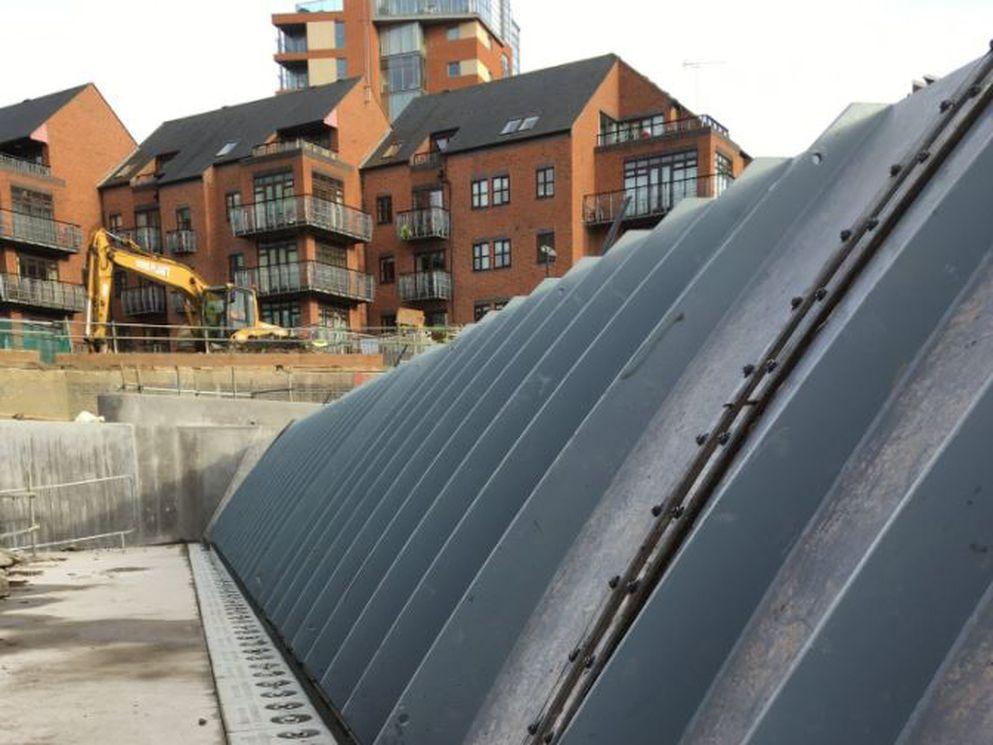£50 million state-of-the-art flood defence scheme opens in Leeds

Camberley, 5 October 2017 - The £50 million flood alleviation scheme in Leeds which uses moveable weir technology – a first for flood risk reduction in the UK – has opened.
The first phase of the award-winning Leeds Flood Alleviation Scheme, delivered by BMMjv (BAM Nuttall and Mott MacDonald), not only uses state-of-the-art flood defence engineering techniques but is one of the largest river flood alleviation schemes in the country.
The scheme comprises three main elements: state-of-the-art mechanical weirs, the merging of the river and canal and flood walls and embankments stretching 4.5km through the city centre.
It is the first time that moveable weirs have been used in the UK for flood alleviation purposes. The new weir gates are supported by giant inflatable neoprene bladders that can be lowered when high river flows are expected. It takes around two hours for the gates to lower, and thanks to the installation of these weir gates, it has been possible to keep flood defence wall heights to a minimum so as not to spoil views of the city centre waterfront.
The weirs have been installed at Crown Point in the city centre and further downstream at Knostrop, where a new locally manufactured bridge has been installed across the weir connecting the diverted Trans Pennine Trail with the north bank of the river.
In addition to these measures, the removal of a manmade island, known locally at Knostrop Cut, which separated the canal and river has been removed to improve a bottleneck for flows. 180,000 tonnes of material excavated from the site has been reused on a local development site and also on diverting the Trans Pennine Trail which previously went across the manmade island. Reusing this material has saved the project in the region of £6 million.
Project Manager for BAM Nuttall, Andy Judson, said: ‘We’ve constructed two moveable weirs, one at Knostrop and one at Crown Point. We’ve provided 36 separate zones of the linear works up through the city centre. The projects main innovation are the moveable weirs, controlled by air bladders. This is the first time this has been used for flood alleviation in the country. We’ve had a really strong ‘one team’ ethos on this project. We’ve all been co-located and understood that by working together, we would get the job finished on time and on budget. We estimated that there are around 125,000 people who have live or work within sight of the project, so there are an awful lot of stakeholders and an awful lot of careful management that has gone into looking after people.’
Led by Leeds City Council in partnership with the Environment Agency, the scheme will provide more than 3,000 homes, 500 businesses and 300 acres of development land with increased protection against flooding from the River Aire and Holbeck.
More than 22,000 jobs will be safeguarded over the next 10 years due to the increased level of protection and through the scheme’s development and construction, 150 jobs and apprenticeships have been created.
The scheme, which sees work on the River Aire now substantially complete and work at Holbeck continuing into autumn, is being officially opened by the Leader of the Council Cllr Judith Blake CBE and Chair of the Environment Agency, Emma Howard Boyd.
Leader of Leeds City Council, Judith Blake CBE, said: ‘We are delighted to see this much-needed first phase of the Leeds Flood Alleviation Scheme opened. As could be seen by the devastation at Christmas 2015, providing increased flood protection in Leeds is essential in terms of reassuring our residents and businesses, and this fantastic state-of-the-art scheme provides it for the city centre and downstream at Woodlesford. The clever use of the mechanical weirs is a brilliant idea, and they have also brought about environmental benefits with the improved river quality bringing salmon and otters, while the new bridge looks stunning offering great views of the river and beyond as part of the Trans Pennine Trail. We’d like to thank everyone involved in this phase of the scheme and look forward to developing the plans for phase two and beyond, as only through an entire catchment and citywide approach can we protect all communities in Leeds from the threat of flooding.’
Chair of the Environment Agency, Emma Howard Boyd, said: ‘This ground-breaking scheme will not only benefit hundreds of homes and businesses in the city but it will also safeguard 22,000 jobs over the next 10 years due to the increased level of protection it provides. It’s been great to see Leeds City Council and the Environment Agency working together in partnership to better protect the city – and it is one of many schemes in the Defra programme investing £430 million to reduce flood risk across Yorkshire before 2021. We’re always looking for new ways that we can use technology to reduce flood risk so it’s exciting that this scheme is also a first for flood risk management in the UK thanks to the use of the moveable weirs which can be lowered when river levels are high. On a day to day basis, people won’t even know they are being protected, and they can enjoy the river which is a key aspect of the city’s South Bank regeneration plans.’
Environmental enhancements have been integral within the scheme design with fish and eel passes installed at both weirs.
Weirs have previously been barriers, preventing species such as salmon migrating from the sea to the spawning grounds further up the river. Salmon have recently been spotted in the River Aire for the first time in 200 years, and now that fish passes have been installed on Knostrop and Crown Point weirs, as well as others on the River Aire, it is hoped that chances of a spawning population of salmon in the river in future will be increased.
Otter ramps and holts have also been installed and will support the local population and 700 trees will be planted along the Trans Pennine Trail later this autumn.
Boxing Day 2015 saw Leeds experience significant and widespread flooding with some of the highest river levels ever recorded. The flooding affected nearly 3,000 residential properties (including indirect impacts to high-riseaccommodation) and 700 commercial properties.



